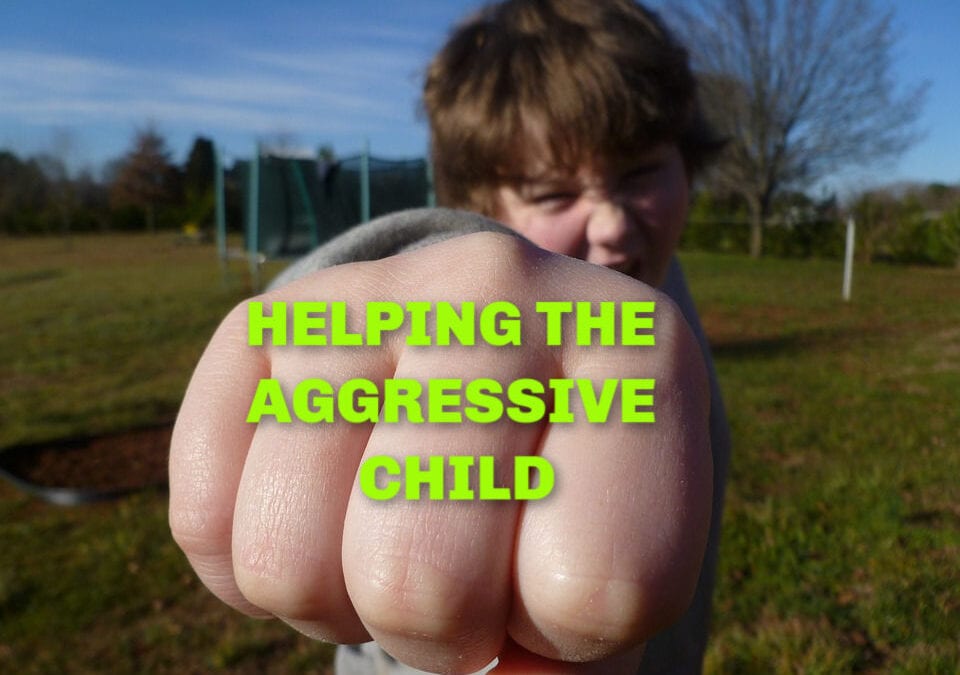Children use all sorts of ways to communicate. Behavior is one of the main ways children communicate because they aren’t yet mature enough to understand many of their thoughts and feelings. Aggression is one of the harder behaviors to decipher because a child often times doesn’t understand the emotions behind their behavior.
Aggression takes on many forms such as the obvious kicking, hitting, or biting, but also can be verbal aggression such as saying, “I hate you!” Adults tend to have better control over their behavior when these feelings arise. Children, however, may use aggression as a way to express their emotions. It is up to the caring adults in the child’s life to teach them other ways to express themselves than through violent behavior toward others.
Most children want to do well, make good choices, and be connected their parents or other caregivers. But sometimes, they enters the “bad kid” cycle.
Here’s how it works:
When your child feels an intense emotion such as anger, anxiety, frustration, or disappointment, he has no idea how to handle this feeling, so he just responds by throwing things, hitting, biting, or slamming doors.
After he engages in these hostile behaviors, he may feel horrible or even shocked about the way he reacted. He may think he is a bad kid. Often, the adult nearby reacts to the behavior by yelling, giving a consequence, or repeating the rules. That response confirms his thought process that he is bad. The more often he thinks this way, the more he believes it. And, the more he believes it, the more often his behavior reflects it.
This cycle is often powered by shame. Shame whispers, “You’re not worthy of love.” A child doesn’t know how to react to this feeling and may either try to ignore it by minimizing his actions, using words to contradict his behavior, or completely pushing you away, verbally or physically. This child doesn’t believe he deserves love because of his bad behavior. Hence, he gets stuck in a vicious cycle.
INTERRUPTING THE CYCLE
Many times, parents are not aware of how much shame their child is experiencing. Your child’s behavior seems like a personal attack. It may seem like your child is intentionally acting out to get their way, or that they know how to handle the situation better, but they are choosing not to. And sometimes, you may be right. But for a lot of aggressive kids, the behavior is a sign that they are stuck in this cycle. What if you could help your child escape this cycle?
TIPS TO BREAK THE CYCLE
- Accept the feelings, not the behavior. You don’t have to agree with their behavior to let them know you understand. One way to do this is to empathize with the struggle and try to put your child’s emotions into words. First, try to acknowledge their feelings. “You look really upset that it is time to clean up the blocks. Your hands felt like throwing when the time to play was up. It’s not always easy to make good choices when we’re frustrated.” Once feelings are identified, you can clarify your expectations.
- Use positive communication. Develop positive communication with your child because rules without relationship leads to rebellion. Communicate with love, respect, and honor. It can be exasperating when children don’t listen or when they behave in ways we don’t like, but speaking disrespectfully will never encourage cooperation or better behavior. It only sets a poor example for communication – one they will likely pick up and use on you or others in the future.
- Set boundaries with love. Creating a safe environment and setting firm limits is important, but it does not need to be done with harshness. Getting to your child’s eye level, offering a hug, redirecting, using a gentle voice, and using a calm, confident presence sends the message, “even though this is big and scary, we can handle it together”. Children need to know what behavior is, and is not, acceptable and boundaries are easier to set if done in a loving way.
- Work on your own anger. It’s difficult to help your child break this cycle if you are stuck in your own shame and anger. Take some time to look at your parenting triggers, and what you can do to help yourself. The way you handle your own anger and frustration affects your child. If you get in your child’s face when he has done something wrong, it will only show your child that aggression is how to solve problems and escalates the situation. Instead, model positive coping skills—like doing something that calms you or getting away from a frustrating situation—and your child is likely to do the same.
- Allow your child to calm down. Giving your child time to calm himself allows the brain to return to a state where they can once again think clearly and react without extreme emotion. It is important to note that each child may need a different type of cooling off – some kids need their own space, some need to be physically close to a caregiver, and some need to be redirected with a calming activity. Your child should be breathing normally, their body has relaxed, and they are able to talk with a normal voice when they are calm. Once they are calm, you can have a conversation about their aggression and practice appropriately expressing their needs and feelings.
- Use empathy. This is a good opportunity to really show your child some empathy and to encourage them to tell you how they feel. Ask your aggressive child, “Can you tell me what is hurting you that made you hurt that other child?” Or you could say, “I know you wouldn’t hurt someone unless something was hurting you.” It’s also important for your child to learn to empathize with the victim of their aggression so that they come to understand how they have affected that person. If your child has hurt you, let them know how sad you are and if they hurt another child, you can tell your child how their actions probably affected that other child. “When you pushed Johnny over, he felt scared and upset too.”
- Use your words. Help your child find new ways to deal with her emotions, especially anger. Once your child has become calm again, it’s time to go back and model the words you’d like her to use, giving her suggestions if needed. If your child is still too young to express themselves verbally, you can speak for them and model what you’d like them to eventually say themselves. The child who was hurt will hear it and feel better, and your child will benefit from hearing their thoughts expressed as well.
- Make Amends. After your child has expressed their feelings and what they want, it’s important for them to try to make things better with the victim of their aggression. Do not force an apology. Making amends is about actively trying to make things right. However, if your child hurts another child, you can apologize to that child on your child’s behalf so that they come to understand what an appropriate apology looks like. The importance of this is that your child understands how their actions affected someone else.
- Commend a job well done. Be sure to praise your child for exhibiting acceptable behavior. Let her know that you notice when she deals with her anger in a positive way.
- Practice self-control. Since children don’t naturally possess the ability to control themselves, they need guidance to develop the ability to keep feelings under control and to think about his actions before acting out. Model self-control yourself by saying phrases that emphasize how you are using control in a situation. An example would be, “I really want a cookie but I am going to eat my dinner first, then I can have one.”
- Use non aggressive forms of discipline. Children model what they are taught. A child who is physically punished can begin to believe this is the correct way to deal with people when you don’t like their behavior. Physical punishment such as spanking can reinforce a child’s aggressiveness toward others. Instead, use other forms of discipline such as natural consequences, redirecting, teaching new skills, cooling off periods, and praising good behavior. If your child still needs to release pent up emotions, find a creative and safe alternative instead. Kids can let off some steam by stomping or dancing, punching a pillow, or pounding clay.
- Be Consistent. For younger kids, consistency is key. It is important to try to respond to behavior the same way every time. You can’t ignore a specific behavior one day and respond by yelling the next day.
- Offer assistance. If you know there are situations that are difficult for your child, give some extra assistance. For instance, if your child has difficulty transitioning from playing with toys to cleaning up, set a timer and remind him he has five minutes left to play. Then remind him at three minutes, two minutes, one minute until the timer goes off. If your child misbehaves when visiting relatives —for example, he starts hitting his cousins—it’s worth having a brief conversation with him letting him know what you expect before you go.
- Coordinate with other caregivers. It’s important to let other caregivers know how you would like certain behaviors to be handled so that everyone is on the same page. Aggressive behaviors such as fighting or hitting can occur in daycare and pre-school as well. It’s part of the way kids learn to interact with each other. You want to coordinate your intervention strategies with the other caregivers in your child’s life so that you’re both consistent. Check in with the caregiver regularly to see what strategies are working and what may need to be reassessed.
- For teenagers: Usually if a teen has been acting out aggressively, it may have started when he was much younger. However, it may look different now that your teen is bigger and stronger than before. Thankfully, these behaviors can change—and they can change at any time. Keep in mind that when you start changing your response to your child and become more empowered, your child will probably act out more initially. You need to stick with it. It’s frightening for teens when their parents begin to take charge. Your child has been used to a certain response from you over the years and may feel a sense of loss of control on his part. So as a result, you have to be consistent in your new responses.
SUPPORT IS AVAILABLE!
Changing and becoming a more effective parent can be a very long process that sometimes seems overwhelming. The key is to be open to different ideas and different ways of doing things. Above all, don’t get discouraged. And while your children are not going to thank you for becoming a more effective parent, down the road you will see them exhibiting the positive behaviors you helped them develop, which is the best reward of all.
If you’re ready to break the cycle for your child, but are still not sure how it works or feel overwhelmed, give us a call at 402.991.0611. A caring therapist can help navigate the feelings of frustration and anger in your child and help you with the challenges of disciplining aggressive behavior. We want to help you find solutions that will help your aggressive child thrive and bring peace back to your home.
References:
Bilich, K. (2019). 8 Ways to Curb Your Child’s Aggressive Behavior. In parents.com. Retrieved from https://www.parents.com/toddlers-preschoolers/discipline/anger-management/6-ways-to-curb-your-childs-aggressive-behavior/
Helping Aggressive Kids: 10 Positive Parenting Tips (2019). In One Time Through. Retrieved from http://onetimethrough.com/helping-aggressive-kids/
Lehman MSW, J. (2019). How to Manage Aggressive Child Behavior. In EmpoweringParents.com. Retrieved from https://www.empoweringparents.com/article/how-to-manage-aggressive-child-behavior/
Schwartz, N. (2019). Love Past the Behavior. In ImperfectFamilies.com. Retrieved from https://imperfectfamilies.com/love-past-behavior/

